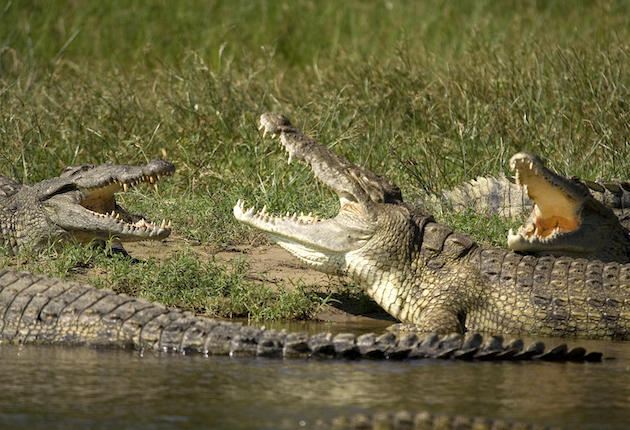Three Nile crocodiles have been captured near Miami over the last decade. While the captures — one in 2009, one in 2011, and one in 2013 — are all individually noteworthy, it’s a recently published study from the University of Florida that is tying all three together in an eerie set of findings.
The study was published in the scientific journal Herpetological Conservation and Biology. According to the paper, the three animals were tested to see if their DNA could pinpoint where they originated and what subspecies of crocodile they stem from. Results showed that the three were, indeed, Nile crocodiles (Crocodylus niloticus), a species native to sub-Saharan Africa and parts of the Mediterranean.
One of the crocodiles was a hatchling, while the other two were in the two- to four-foot range. Two were related to one another; the third was likely related to the others, but the results were “too difficult to read after multiple DNA isolations.”
None of the croc DNA matched that of the specimens kept at nearby Disney’s Animal Kingdom, leading the researchers to believe their presence resulted from the illegal pet trade.
The paper also related its findings on the growth rate of Nile crocodiles in Florida against the growth rates of other reptiles discovered by separate research teams. At its best, the native American alligator can grow 35 centimeters per year (based on data collected on East Texas gators). In Florida, the alligator grows roughly 31 centimeters a year.
By comparison, the Nile crocodile can grow 31.7 centimeters in its native Zimbabwe.
In Florida? The Nile crocodile was found to grow a whopping 40.5 centimeters (~16 inches) per year … 28 percent faster than it would have in Africa. They top out at 16 feet and 1,600 pounds.
So, can’t you just kill them if they crawl into your backyard? After all, they are non-native, right?
Not even close. Penalties for killing a Nile crocodile in Florida could be even higher than killing an American alligator out of season. The U.S. Fish and Wildlife Service recognizes the Nile crocodile as Endangered, regardless of where it is located. This stretches into areas it has escaped into, been illegally introduced into, or wandered into — hence the Nile crocodiles’ special treatment in the Sunshine State. Even the University of Florida researchers had to apply for special permission to capture/euthanize the species.
Four additional subspecies have been introduced into Florida since the 1960s: the Slender-Snouted, Cuvier’s Dwarf Caiman, Schneider’s Smooth-Fronted Caiman, and Spectacled Caiman. Only the Spectacled has established a lasting presence, but even one invasive species is too much in an ecosystem as fragile as the Everglades.
Florida is also home to a native crocodilian — the American crocodile (Crocodylus acutus) is found along the southern coastline of the peninsula and out into the Keys.
Nile crocodiles have been introduced to Mississippi and Florida in the past but were recaptured before they established themselves in the environment. No population is known to exist in either state, but researchers and biologists worry that the species could thrive in the Deep South climate of the Gulf states.
The paper’s focus on Floridian crocodiles is dramatic enough, but its opening words are the most distressing. According to the researchers, Florida has more introduced herpetofauna (reptiles and amphibians) than any other governmental region on earth. From crocs to Burmese pythons to who knows what else, the state is becoming overridden with introduced species that will continue to negatively effect native animals.


Seems like another manmade dilemma for Floridians…will we ever learn that exotics don’t make good pets? If established in the Everglades, the Nile crocs would be as serious threat to native wildlife and humans as the Burmese python. Some 200+ people each year disappear as victims of Nile crocodiles in sub-Saharan Africa…guess Floridians will be equally tasty as will be their pets and small children.